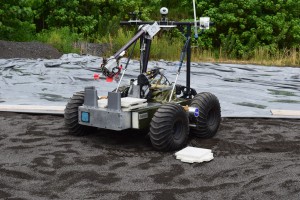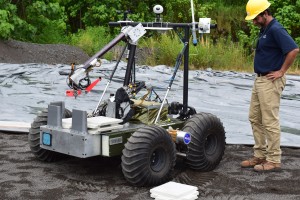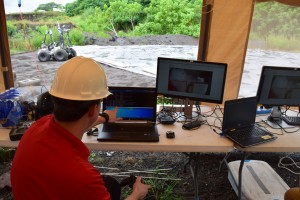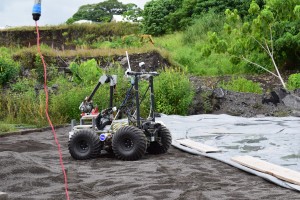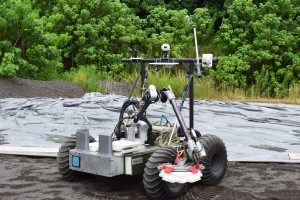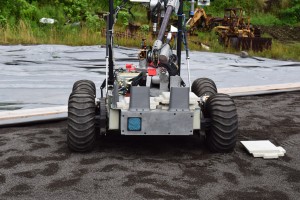PISCES Unveils Basalt Landing Pad
On Wednesday morning, Big Island Now got an exclusive on the ground look at the Pacific International Space Center for Exploration Systems’ new lunar landing pad site, located at Puna Rock in Kea’au.
The construction project, which began during the fall, was recently completed through a partnership between PISCES and the NASA.
“It’s a pleasure to announce today the completion of the first technical milestone with NASA, in the grading, leveling, and compacting of the inner area of our bullseye on our landing pad that we have been working on,” said Rob Kelso, PISCES Executive Director. “The federal government asked us to complete it by last year’s fiscal year, Sept. 30. With a very aggressive schedule and a lot of team work, we were able to do that.”
PISCES Helelani rover, outfitted with a robotic arm, demonstrated how the landing pad would be built using basalt concrete, which was has also been tested along Kinoole Avenue in Hilo, near the Lincoln Park tennis courts.
The rover’s method of placing basalt pavers on the site is hoped to be one day used in space.
County representative Donn Mende, director of the Hawai’i County Department of Research and Development, was present at the tour, representing the county’s partnership with PISCES in the project.
Jason Schuler, an engineer with NASA Swamp Works and Magnus Hedlund, Systems Engineer with Honeybee Robotics, were also present to discuss the partnerships, as well as technical aspects of the rover and the system of the rover’s movement.
“The construction project is really unique. Instead of concrete for the landing pad, we’re using lunar and Mars material, which is exactly like the material we have here on the Big Island – basalt,” Kelso said. “And secondly, instead of a human workforce building construction for the landing pad, we’re using robotics.”
Basalt is a highly prized resource for the project due to its like-ness of what would be found outside of the earth. Testing of the basalt is believed to be a possible way to build in space without having to haul materials from earth.
Space building isn’t the only hopeful use of the basalt. Kelso discussed the state’s look at resources already at home, and could be the future of construction for things like patios, and sidewalks.
“Right now, the state is beginning to look at construction projects that don’t use the 300,000 tons of Portland cement that are imported into the islands each year for roads, sidewalks, foundations, etc. The state is very interested right now to look at alternative construction material to include basalt,” Kelso said. “In addition to that, the paver technique of cooking the basalt pavers out of the fines we find here in Hawai’i could pave the way for having these types of pavers for patios, fire places, high-temperature furnaces, and many lanais. There are many different applications.”
Next on PISCES list is placing the pavers onto the launch pad so that simulated land can test their durability.
The basalt landing pad project is one aspect of PISCES’ Additive Construction for Mobile Emplacement project, in partnership with NASA, Swamp Works, Honeybee Robotics, ARGO, Hawai’i County Department of Research and Development, and the State of Hawai’i.







